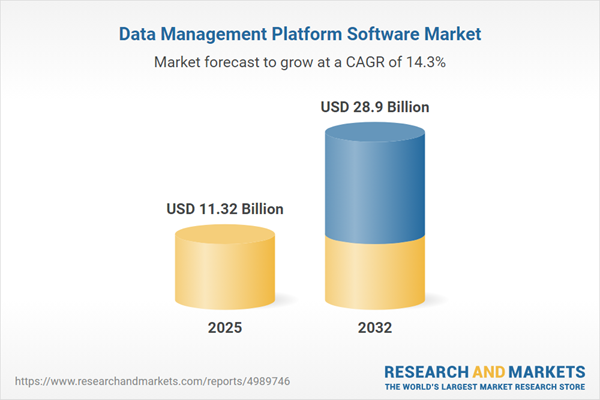Speak directly to the analyst to clarify any post sales queries you may have.
Data management platform software is reshaping how organizations gather, organize, and activate customer and operational data within an increasingly complex digital environment. As enterprises contend with rapid digital expansion, this solution class provides a central foundation for unified data-driven decision-making at executive levels.
Market Snapshot: Data Management Platform Software Market
The Data Management Platform Software Market grew from USD 9.90 billion in 2024 to USD 11.32 billion in 2025 and is projected to achieve a CAGR of 14.32%, reaching USD 28.90 billion by 2032.
This robust expansion underscores the strategic priority organizations assign to centralized data solutions for competitive differentiation, regulatory readiness, and operational excellence.Scope & Segmentation
- Data Type: First Party Data, Second Party Data, Third Party Data
- Deployment: Cloud (Private Cloud, Public Cloud), Hybrid, On Premises
- End User Industry: BFSI (Banking, Capital Markets, Insurance), Government & Public Sector (Federal, State & Local), Healthcare (Hospitals, Pharmaceutical), Media & Entertainment (Gaming, TV & Radio), Retail (Brick And Mortar, Ecommerce), Technology & Telecom (Information Technology, Telecom)
- Organization Size: Large Enterprises, Small And Medium Enterprises
- Region: Americas (North America—including United States, Canada, Mexico; Latin America—including Brazil, Argentina, Chile, Colombia, Peru), Europe, Middle East & Africa (Europe—including United Kingdom, Germany, France, Russia, Italy, Spain, Netherlands, Sweden, Poland, Switzerland; Middle East—including United Arab Emirates, Saudi Arabia, Qatar, Turkey, Israel; Africa—including South Africa, Nigeria, Egypt, Kenya), Asia-Pacific (China, India, Japan, Australia, South Korea, Indonesia, Thailand, Malaysia, Singapore, Taiwan)
- Leading Companies: Adobe Inc., Oracle Corporation, Salesforce, Inc., Neustar, Inc., Lotame Solutions, Inc., SAS Institute Inc., Tealium Inc., SAP SE, Nielsen Holdings plc, Experian plc
Key Takeaways for Senior Executives
- Unified data management platforms drive actionable insights by connecting fragmented data sources, ensuring organizations deliver timely personalization and streamlined compliance management.
- Privacy-by-design and embedded consent management capabilities reflect the need to meet dynamic regulatory demands alongside robust data governance mandates.
- Integration of AI-powered analytics within these platforms enables precise predictive modeling, allowing teams to anticipate trends and make informed, agile business decisions.
- Flexible deployment models—whether cloud-based, on-premises, or hybrid—support varying security, compliance, and scalability requirements across multiple sectors and regions.
- Strategic partnerships between software vendors, technology providers, and industry consortia foster innovation, accelerate platform deployment, and strengthen data sovereignty and resilience.
- Segment-specific needs highlight the unique ways banking, government, healthcare, media, retail, and telecom organizations unlock value and operational gains from advanced data orchestration.
Tariff Impact and Supply Chain Adaptation
The introduction of United States tariffs in 2025 has directly influenced procurement costs and supply chain efficiency for data management platform software. Enterprises shifting to cloud-native infrastructure have reduced exposure to hardware price volatility, while localizing data center partnerships and diversifying sourcing strategies have enhanced operational resilience. Leading vendors have responded with modular, tiered offerings and granular licensing, preserving budgetary discipline as enterprises adapt to evolving global trade pressures.
Methodology & Data Sources
This research blends primary interviews with senior technology leaders and practitioners, secondary review of industry publications and vendor materials, and cross-validation through triangulation. Case study analysis and strict data governance underpin the accuracy and reliability of findings.
Why This Report Matters
- Empowers decision-makers with clarity on technology and regional dynamics shaping data management platform adoption.
- Delivers practical segmentation insights and supplier differentiation to drive strategic planning and investment allocation.
- Supports enterprise transformation initiatives by translating complex market and technology trends into actionable intelligence.
Conclusion
Strategic investment in data management platform software positions organizations to lead in personalization, compliance, and operational resilience. Tailored solutions and expert partnerships ensure adaptability. Forward-looking leaders leverage these insights to fuel sustainable growth and competitive strength.
Additional Product Information:
- Purchase of this report includes 1 year online access with quarterly updates.
- This report can be updated on request. Please contact our Customer Experience team using the Ask a Question widget on our website.
Table of Contents
3. Executive Summary
4. Market Overview
7. Cumulative Impact of Artificial Intelligence 2025
Companies Mentioned
The companies profiled in this Data Management Platform Software market report include:- Adobe Inc.
- Oracle Corporation
- Salesforce, Inc.
- Neustar, Inc.
- Lotame Solutions, Inc.
- SAS Institute Inc.
- Tealium Inc.
- SAP SE
- Nielsen Holdings plc
- Experian plc
Table Information
| Report Attribute | Details |
|---|---|
| No. of Pages | 187 |
| Published | November 2025 |
| Forecast Period | 2025 - 2032 |
| Estimated Market Value ( USD | $ 11.32 Billion |
| Forecasted Market Value ( USD | $ 28.9 Billion |
| Compound Annual Growth Rate | 14.3% |
| Regions Covered | Global |
| No. of Companies Mentioned | 11 |









